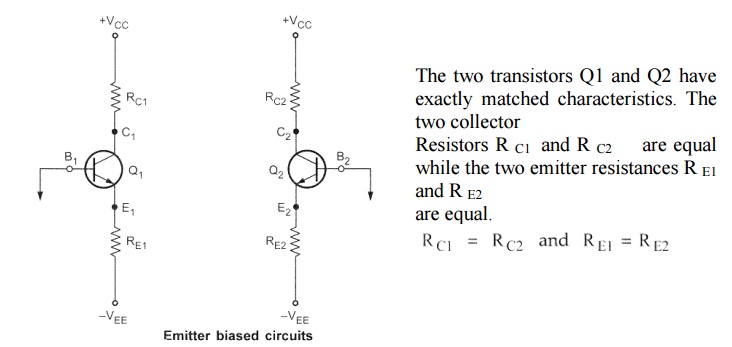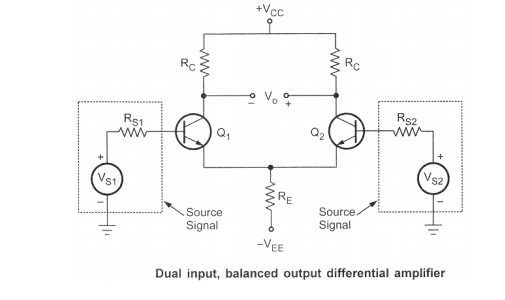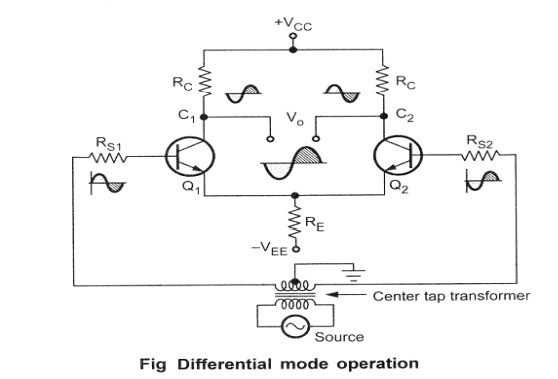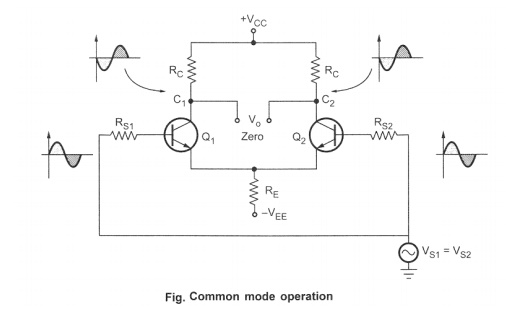Chapter: Electronic Circuits : BJT Amplifiers
Transistorised Differential Amplifier
Transistorised Differential
Amplifier
The
transistorised differential amplifier basically uses the emitter biased
circuits which are identical in characteristics. Such two identical emitter
biased circuits are

The
magnitudes of + Vcc and – V EE are also same. The differential
amplifier can be obtained by using such two emitter biased circuits. This is
achieved by connecting emitter E1 of Q1 to the emitter E2 of Q2. Due to this, R
E1 appears in parallel with R E2 and the combination can
be replaced by a single resistance denoted as R E. The base B1
of Q1 is connected to the input 1 which is V S1 while the base B 2
of Q2 is connected to the input 2 which is Vs2. The supply voltages
are measured with respect to ground. The balanced output is taken between the
collector C1 of Q1 and the collector C2 of Q 2. Such an amplifier is
called emitter coupled differential amplifier. The two collector resistances
are same hence can be denoted as R C..
The
output can be taken between two collectors or in between one of the two
collectors and the ground. When the output is taken between the two collectors,
none of them is grounded then it is called balanced output, double ended output
or floating output. When the output is taken between any of the collectors and
the ground, it is called unbalanced output or single ended output. The complete
circuit diagram of such a basic dual input, balanced output differential
amplifier is shown in the Fig.

As the
output is taken between two output terminals, none of them is grounded, it is
called balanced output differential amplifier.
Let us
study the circuit operation in the two modes namely
• Differential
mode operation
• Common
mode operation
1. Differential Mode Operation
In the
differential mode, the two input signals are different from each other.
Consider the two input signals which are same in magnitude but 180" out of
phase. These signals, with opposite phase can be obtained from the center tap
transformer. The circuit used in differential mode operation is shown in the
Fig

Assume
that the sine wave on the base of Q 1is positive going while on the
base of Q 2 is negative going. With a positive going signal on the
base of Q 1 , m amplified negative going signal develops on the
collector of Q1. Due to positive going signal, current through R E
also increases and hence a positive going wave is developed across R E.
Due to negative going signal on the base of Q2, an amplified positive going
signal develops on the collector of Q 2 . And a negative going
signal develops across R E, because of emitter follower action of Q 2.
So signal voltages across R E, due to the effect of Q1 and Q2 are
equal in magnitude and 180o out of phase, due to matched pair of transistors.
Hence these two signals cancel each other and there is no signal across the
emitter resistance. Hence there is no a.c. signal current flowing through the
emitter resistance. Hence R E in this case does not introduce
negative feedback. While Vo is the output taken across collector of Q1 and
collector of Q 2. The two outputs on collector L and 2 are equal in
magnitude but opposite in polarity. And Vo is the difference between these two
signals, e.g. +10 - (-10) = + 20.
Hence the
difference output Vo is twice as large as the signal voltage from either
collector to ground
2. Common Mode Operation
In this
mode, the signals applied to the base of Q1 and Q2 are derived from the same
source. So the two signals are equal in magnitude as well as in phase. The
circuit diagram is shown in the Fig.
In phase
signal voltages at the bases of Q1 and Q2 causes in phase signal voltages to
appear across R E, which add together. Hence R E carries
a signal current and provides a negative feedback. This feedback reduces the
common mode gain of differential amplifier.

While the
two signals causes in phase signal voltages of equal magnitude to appear across
the two collectors of Q 1 and Q2. Now the output voltage is the
difference between the two collector voltages, which are equal and also same in
phase, Eg. (20) - (20) = 0. Thus the difference output Vo is almost zero,
negligibly small. ideally it should be zero.
Related Topics